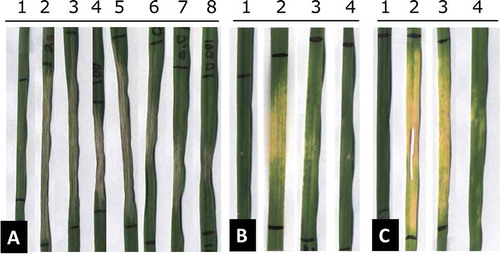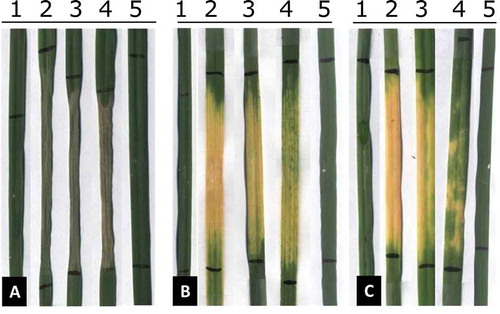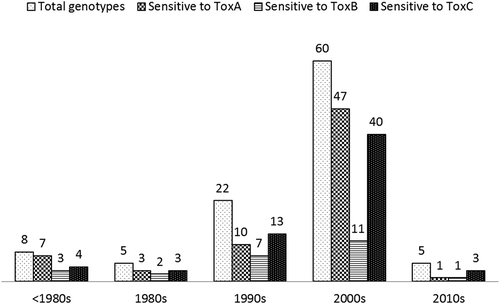Figures & data
Table 1. Reaction of a collection of wheat genotypes to heterologously expressed Ptr ToxA, Ptr ToxB and spore germination fluids possessing putative Ptr ToxC activity.
Fig. 1 Sodium dodecyl sulphate-polyacrylamide gel electrophoresis (SDS-PAGE) of His-tagged Ptr ToxA heterologously expressed in Escherichia coli. Lane 1, molecular markers (Precision Plus Protein, Bio-Rad Canada); the relative abundance of the toxin protein after incubation of bacterial cultures with 0.2% L-arabinose for 0 h (lane 2), 1 h (lane 3), 2 h (lane 4), 3 h (lane 5), 4 h (lane 6), or overnight (lane 7) is shown. The band corresponding to Ptr ToxA is noted.

Table 2. Induction of necrosis by His-tagged Ptr ToxA on the sensitive wheat ‘Glenlea’.
Fig. 2 (Colour online) Symptoms induced by the necrotrophic effectors of Pyrenophora tritici-repentis on the reference wheat genotypes ‘Salamouni’, ‘Glenlea’, 6B662 and 6B365. (a) Symptom development 48 h after infiltration with His-tagged Ptr ToxA: ‘Salamoumi’ infiltrated with 3.5 µM Ptr ToxA (1); and ‘Glenlea’ infiltrated with 3.5 µM (2), 1.4 µM (3), 0.6 µM (4), 0.3 µM (5), 0.1 µM (6), 0.01 µM (7) or 0.001 µM (8) Ptr ToxA. (b) Symptom development 120 h after infiltration with His-tagged Ptr ToxB: ‘Salamoumi’ infiltrated with 10 µM Ptr ToxB (1); and ‘6B662’ infiltrated with 10 µM (2), 5 µM (3) or 0.5 µM (4) Ptr ToxB. (c) Symptom development two weeks after infiltration with fungal spore germination fluids with putative Ptr ToxC activity: ‘Salamoumi’ infiltrated with a 1:10 dilution of spore germination fluids: water (1); and 6B365 infiltrated with 1:10 (2), 1:20 (3), or 1:50 (4) dilutions of spore germination fluids: water.

Fig. 3 (Colour online) The sensitivity of selected wheat cultivars to His-tagged Ptr ToxA, His-tagged Ptr ToxB and spore germination fluids with putative Ptr ToxC activity. (a) Sensitivity to Ptr ToxA in ‘Salamouni’ (1), ‘DT 570’ (2), ‘CDC Teal’ (3), ‘AC Crystal’ (4) and ‘Infinity’ (5). (b) Sensitivity to Ptr ToxB in ‘Salamouni’ (1), ‘Katepwa’ (2), ‘Eatonia’ (3), ‘Journey’ (4) and ‘Maquis’ (5). (c) Sensitivity to Ptr ToxC in ‘Salamouni’ (1), ‘Minnedosa’ (2), ‘PT 580’ (3), ‘Burnside’ (4) and ‘Red Fife’ (5).

Fig. 4 The sensitivity of wheat cultivars released prior to the 1980s or from the 1980s to the 2010s to Ptr ToxA, Ptr ToxB and spore germination fluids with putative Ptr ToxC activity. The number of cultivars is indicated on the top of each bar.

Table 3. Reaction of the wheat genotypes to heterologously expressed Ptr ToxA, Ptr ToxB and spore germination fluids possessing putative Ptr ToxC activity, grouped by wheat class.
Table 4. Reaction of wheat genotypes insensitive to all three necrotrophic effectors from Pyrenophora tritici-repentis to inoculation with isolates of the fungus producing those effectors.
